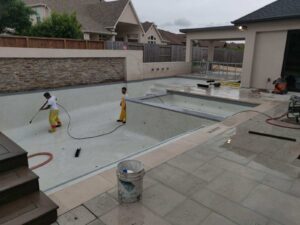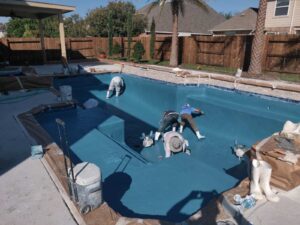Sugar Land, TX Pool Plastering Near Me company JR Pool Plastering & Texas Gunite Ltd. can definitely help you remodel your pool to your liking and preference. Pool plastering projects help keep your pool looking great and extend its lifespan.
Taking care of your pool the right way can go a long way in keeping it going for many years. Plastering your pool is an important step in maintaining it in good condition.
Owning a pool requires a lot of responsibility, and one of the things that people don’t think about much is how a pool needs to be replastered after a while. It’s recommended that pool owners replaster their inground pool every ten years.

This Sugar Land, TX Pool Plastering Near Me can help you repair and remodel your pool.
To extend the life of your pool, there are some measures that you can implement into your maintenance routine. After some years, the pool will have to be repaired and eventually replaced altogether. Before you take on the pool problems you currently face, consider whether the pool has more problems than you can realistically fix.
Here Are Some Signs That It’s Time To Replaster
If you see multiple of these symptoms in your pool, the pool may face long-term problems.
Stains
Pool plaster will experience some staining no matter what because it is made of natural material that will take up colored substances. More problems will happen if the pool’s water chemistry is bad. Poor water chemistry can lead to new stains on replastered pools quicker than you would like.
Acid washing can help with stains, but only to a certain extent. If your pool has mild staining, acid washing will be the perfect solution. Generally, acid washes don’t happen that often because they can lead to roughness on the pool’s surface. Roughness on the surface is basically the indication that plaster needs to be replaced.
Ask your pool contractor about products that can enhance your pool plaster.
Roughness

Our professional pool builders are here to help!
After some time or excessive acid washing, the surface of the pool will start to become rough. This can happen faster than normal for pools with poorly done plastering jobs. This can cause snagged swimsuits, scraped skin, and algae that can be hard to remove. For small areas, sanding the plaster down is an option. The plaster will need to be replaced completely for larger areas of roughness throughout the pool.
Thinning, Chipping, and Leaks
If your pool has dark spots that don’t look like stains, the pool’s plaster may be too thin in these areas. Thin plaster allows underlying concrete to get through, which is a major safety concern. Plaster is an effective protective waterproof layer, so it’s a major safety concern if it becomes that thin.
Some pools will see their plaster come off completely. When plaster does come off completely, the chips of plaster fall off or cracks begin to form. Some products in the market are able to fix small cracks and chips. However, if the number of small cracks and chips is too high, the pool may need to be replastered. JR Pool Plastering & Texas Gunite Ltd. can be the answer to your Sugar Land, TX Pool Plastering Near Me search.
Loss Of Color
Pools that use a colored plaster other than white can see their pool’s surface lose color over time. This is due to poor water chemistry or the material used to create the color. Plaster companies will use organic pigments of color in their plaster to reduce production price, but this organic color pigment will fade faster. The best solution for loss of color is using a Sugar Land, TX Pool Plastering Near Me company that uses inorganic color pigments in their plaster.
Replastering Process
A pool replastering project can take days to a few weeks, depending on the size and complexity of the pool. The first step is removing the old plaster and pouring in the new one. After pouring the plaster, it is cured and allowed to harden.
Rough surfaces are evened out, and the finishing touches are applied. This allows the plaster to shine at its maximum potential. Following this step, the pool will need to be refilled.
When Should You Replaster Your Pool?
Replastering your pool is a must throughout its lifespan. One important aspect of this is the timing of repair services.
Generally, you’ll want to replaster in the temperature range around 50 and 75 degrees. Depending on where you are located, that type of temperature may happen in the spring or fall. Replastering when temperatures are colder than 50 degrees Fahrenheit is not recommended. If temperatures are too hot or too dry, they can affect the plastering project by drying, making it dry too fast and leading to tiny cracks.
Wind should also be considered during plastering projects because it can blow dirt and debris, causing it to get stuck in the wet plater. The way this sounds, you may be wondering why plastering has to be so difficult. If you can’t figure out when to replaster your pool, you can definitely ask one of our representatives. We’ll help you figure everything out.

Let JR Pool and Plastering & Texas Gunite provide the River Oaks TX Swimming Pool Remodeling services you need!
For questions about the cost of replastering a pool, there are a few variables to keep in mind, like:
- Size of pool
- Shape of pool
- Colors or finishes
Out of those three, the size and shape of the pool are very important variables for the pricing of replastering projects. Some pools are designed and shaped uniquely and may require special procedures to replaster, raising the price.
The reason that bigger pools are more expensive is the increase in work required and material used. The plastering color can also play a part in the overall costs. For more information, get in touch with one our Sugar Land, TX Pool Plastering Near Me representatives.
- Sugar Land is located approximately 20 miles from downtown Houston.
- Sugar Land was founded as a sugar plantation in the mid-1800s
- Officially incorporated in 1959